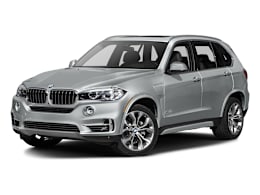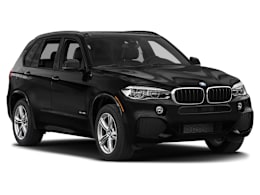With the X5's redesign, BMW has dialed back the sharp handling and taut ride of previous models, trading some of their sporty feel for a cushier ride that makes it seem, well, less BMW-like. The cabin is now more luxurious, solid, and quiet. Fit and finish are impeccable, and it's loaded with an array of up-to-date electronic features. The result is a very comfortable, refined, and high-tech SUV, although one that's less engaging to drive than previous X5s.
The generous list of standard equipment doesn't include a backup camera, which is inexcusable at this price. Our X5 had the optional Driver Assistance Plus package, which includes several active safety systems that can even brake the vehicle when needed to avoid an accident.
The standard 300-hp, 3.0-liter turbocharged six-cylinder engine and eight-speed automatic transmission deliver silky-smooth, effortless performance with plenty of reserve power. And it can tow up to 6,000 pounds. With its commendable fuel economy of 21 mpg overall, the X5 is tied with the Lexus RX 350 as the most efficient non-hybrid luxury SUV we've tested.
For those craving more power, a 445-hp, 4.4-liter twin-turbocharged V8 comes in the xDrive50i. A 255-hp, 3.0-liter six-cylinder turbodiesel is also available and should provide even better fuel economy.
The X5 may no longer be one of the sportiest luxury SUVs to drive, but it remains extremely competent and composed. Steering effort is much lighter than before, making parking and low-speed maneuvers easier, but there is less tactile feedback. When pushed to its handling limits, the X5 was stable and secure, and it posted a commendable speed in our avoidance maneuver.
Though the ride is still firm and jiggly at low speeds, partly because of the run-flat tires, it is much improved. Gone is the constant choppiness of the previous X5, replaced with more isolation and gradual body motions that make this one feel more settled.
Inside, you'll find a plush and well-constructed interior, with padded surfaces and handsome wood and brushed-chrome trim. There's plenty of room for the driver, as well as a standard power-adjustable tilt-and-telescoping steering wheel. The front seats are very comfortable and supportive, and passengers get the same 10-way power-seat adjustments as the driver. Visibility is refreshingly good, which is something we can't say about many new vehicles.
The second-row seat is firm, well-shaped, and supportive, with good leg and head room. But the cushion is a bit low, which reduces thigh support. Opting for the $1,700 third row adds two folding jump seats, but the space is super-snug.
Large doors and ample rear floor space help access, but it's a bit of a step up to get into the X5, and the wide rocker panel can soil clothing.
Gauges are large and easy to read, and an optional heads-up display helps keep your eyes on the road. The iDrive control system takes some getting used to, but BMW moved the central lock switch to the doors and labeled a few controls better. Electronic and connectivity features have also improved, with faster response time and better voice controls. Pairing a phone is easy, and iPhone users can access a variety of Internet radio stations and apps using the X5's screen.




















